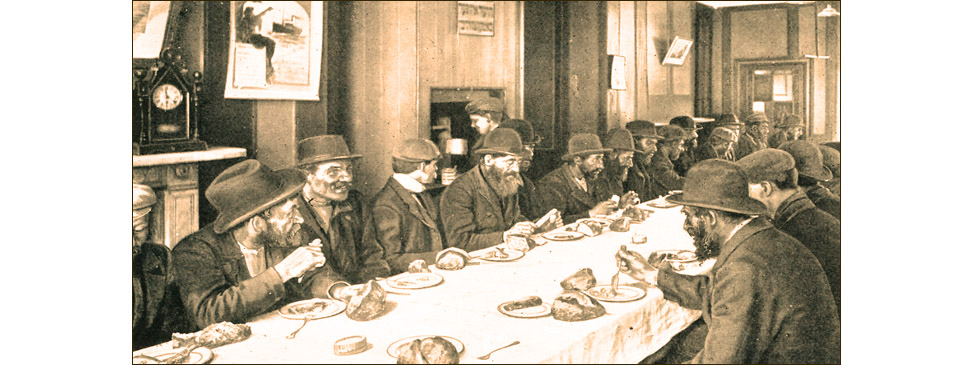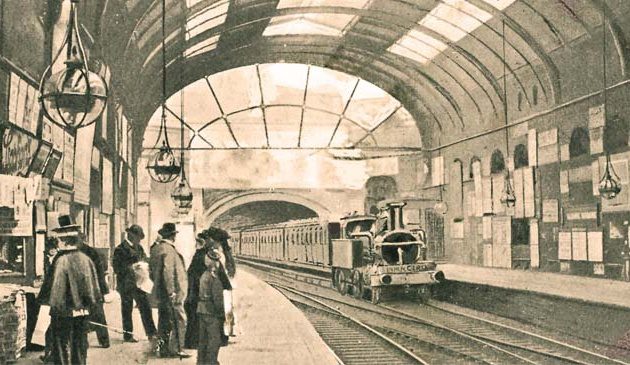London’s Jewish Community in the 19th century. Part 2 – Their lives

Newly-arrived men are provided with a frugal meal at the Poor Jew’s Temporary Shelter in around 1885. It began in Church Lane, Whitechapel. Sir Samuel Montagu and others took it over and provided a building in Leman Street to give a home for new arrivals for up to two weeks. It eventually sheltered up to 4,000 immigrants each year.
In the mid-19th century, prior to the arrival of the East Europeans, one of the main sources of employment for Jews was in the cigar trade, which was largely the preserve for Dutch immigrants. It was a business in which there were at least as many women as men. Later in the century the first cigarette manufacturers were Jews but a mix of Russian, Dutch, Greeks and Germans. Unlike cigar-making, cigarettes relied on mechanisation and was lower-skilled, lower-paid work.
Most East European immigrants arrived with little money so needed to urgently seek work. They rarely spoke English, so their options were limited. Most were able to find employment with a relative, or others from the same area from where they had migrated, perhaps even the same village. They joined what were called the ‘Jewish trades’, usually carried on in sweatshops, or from their home, in and around Whitechapel.
One such trade was shoe and boot-making, which for a time in the latter part of the 19th century employed many Jews. It was, however, a business that was modernizing, moving from bespoke hand-made shoes produced by out-workers in homes or small sweatshops to mass-production in large factories. With declining income for workers due to mechanization, the National Union of Boot & Shoe Rivetters organized a strike in 1889, which largely brought the trade into larger workshops, gradually bringing an end to Jewish sweatshops. By the end of the 19th century there were only a small number of East End Jewish workshops continuing in the business.
There was a growing affluence amongst England’s workers in the second half of the 19th century, with a rapidly-expanding population in London, and for the first time they had some disposable income. They looked to spend some of their hard-earned money on inexpensive clothes and furniture. Thus, there was an increasing market for competitively-priced, off-the-peg clothing that matched as close as possible the bespoke, tailored attire of the upper classes. It was Jewish sweatshops around Whitechapel where many of those were produced, in part or whole. In the latter part of the 19th and early 20th century many Jews – 42% of male East European immigrants and 54% of women – were employed around Whitechapel in the garment trade.
The Jewish connection with the rag trade went back into the 17th century when they dealt in second-hand clothes outside the City at Houndsditch. The association of the trade with the area preceded the Jews. The Tudor historian John Stow wrote of some cottages at Spitalfields: “which houses be for the most part possessed by brokers, sellers of old apparel and such like”. In the early 18th century poorer Jews living at the ‘Rag Fair’ at Rosemary Lane (later re-named Royal Mint Street) walked the streets of London buying used clothes, crying “Old clo! Old clo!”. These were taken back to be repaired and re-sold as clothes or rags, a process known as ‘clobbering’. The old Petticoat Lane market (Middlesex Street) that runs between Bishopsgate and Aldgate, and where Huguenots had earlier sold their lace, was taken over by Jewish garment retailers during the 1880s and 1890s. At the other end of the scale, a small number of German Jews worked as bespoke tailors in Soho. Isaac Moses and his brother began selling clothes in the Jewish quarter at Houndsditch before moving westwards, where they opened their first Moss Bros. shop at Covent Garden in 1851, growing into one of Britain’s largest clothes retailers under various brand names.
In 1867 the American businessman Isaac Singer opened a factory near Glasgow to manufacture his new sewing machines and their availability gave an army of unskilled journeymen and women the ability to produce garments. The production process of any garment involved a highly competitive division of labour. For example, one person cut the cloth, another made buttonholes. A man’s suit involved about 25 subdivisions, each passing on to the next. Few of the workers had the skill to make more than their part of an article. Some work was done in small gas-lit workshops, but also with many outworkers toiling in their home. Jews tended to concentrate on certain parts of the chain, such as machining and pressing, and mostly the production of garments such as coats and waistcoats. A hierarchy was established, with the ‘greeners’ (usually recent male and female immigrants) taking on the less skilled work at lower wages. In 1887 over a thousand small garment workshops were counted in Whitechapel, although perhaps this included those within the home.
The arrival of penniless Jewish immigrants decreased wages across the whole garment trade. The work was seasonal and subject to fluctuation. In some years the economy was strong, and weak in others. Slack times were dire for both employer and employees. Workshops regularly opened and closed. Greeners, were selected for the following week’s work by employers on Whitechapel Road during the Saturday Sabbath, at what was known as the ‘hazer mark’, Yiddish for pig market. Workshops were normally filthy and unhealthy, the working hours long, and the pay low. Regulations prior to the Factories & Workshops Act of 1901 were lax, with virtually no control of working conditions for adults. The few convictions of Jewish workshop owners were for working on the Jewish Sabbath. Wages were unregulated until the Trade Boards Act of 1909.
In Britain it was forbidden to trade from a shop on Sunday, the Christian Sabbath. An exception was made for shops owned by Jews, whose Sabbath was on Saturday. Sunday markets therefore evolved at Petticoat Lane, Goulston Street, Columbia Road, and Sclater Street off Brick Lane. The writer S. Gelberg, wrote of Petticoat Lane: “On Sunday Middlesex Street and its adjoining thoroughfares are a howling pandemonium of cosmopolitan costerism, a curious tangle of humanity… the most abiding impression it leaves on your mind as you struggle out of its seething, shouting gesticulating population is of infinite picturesqueness, and the life-stream tumbling like a swirling torrent along its course”. English shop-keepers complained, however, that some Jewish owners took away their business, respecting neither Sabbath, and trading every day for long hours.


